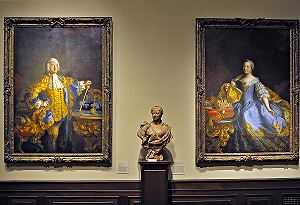 click for large |
PORTRAIT OF EMPEROR FRANCIS I OF AUSTRIA PORTRAIT OF EMPRESS MARIA THERESA OF AUSTRIA Martin van Meytens the Younger SN 325 & 326, oils on canvas From: "The Pages" |
ARTIST:
The Meytens were originally a Dutch family of painters of Flemish origin. [The name has been spelled variously as Mytens or Mijtens.] The earliest was Aert Mijtens (1541-1602). Martin Meytens I (1648-1736) moved to Sweden, where he worked as a portrait painter. His son Martin Meytens II, was born in Stockholm, and became portrait painter to the Imperial Austrian court in Vienna.
After training with his father he began his career painting small enamel pictures in London, Paris, Vienna, and Italy. Around 1730 he settled in Vienna, where he was appointed court painter in 1732. He portrayed not only the nobility but scholars and artists as well, in subtly characterized, ¾ length portraits which showed his convincing powers of observation. He also played a leading role in Vienna’s art life, in charge of a large studio and organizing important projects. He enjoyed royal favor into his old age, spoke many languages, played music, and was greatly interested in physics and mineralogy.
SUBJECT:
These are royal state portraits of Francis & Maria-Theresa, Emperor & Empress of Austria. Although he is more elaborately dressed, his family was less important; accession to the throne came through her lineage. They were married in 1736, and she was made Queen of Hungary and Bohemia a few years later. In 1745 they were both made rulers of the Holy Roman Empire..
They shared a very happy marriage, and had 16 children…the most famous being Marie Antoinette, who became Queen of France. [See Vigée-Lebrun’s portrait of Marie, Gal 17.] Maria-Theresa outlived her husband by fifteen years, dying in 1780 at the age of 63.
PAINTING:
As befits state portraits, the sitters’ clothing is opulent. Francis is quite the peacock; his blue coat is heavily braided in gold, with yards of impressive lace ruffling. He wears the Order of the Golden Fleece, and holds a scepter. Maria-Theresia is not as fancy, nevertheless she looks commanding. In both portraits there is a gilt console table – perhaps part of the furnishings of their new home, Schöenbrun Palace, in Vienna.
There are 5 crowns visible – 4 on her pillow: the Austrian Herzoghut, the Hauskrone of the Hapsburg Emperors, the Wenzelkrone and the Stephanskrone of Hungary. His crown is that of the Holy Roman Empire. The other object on his table is the Reichsapfel.